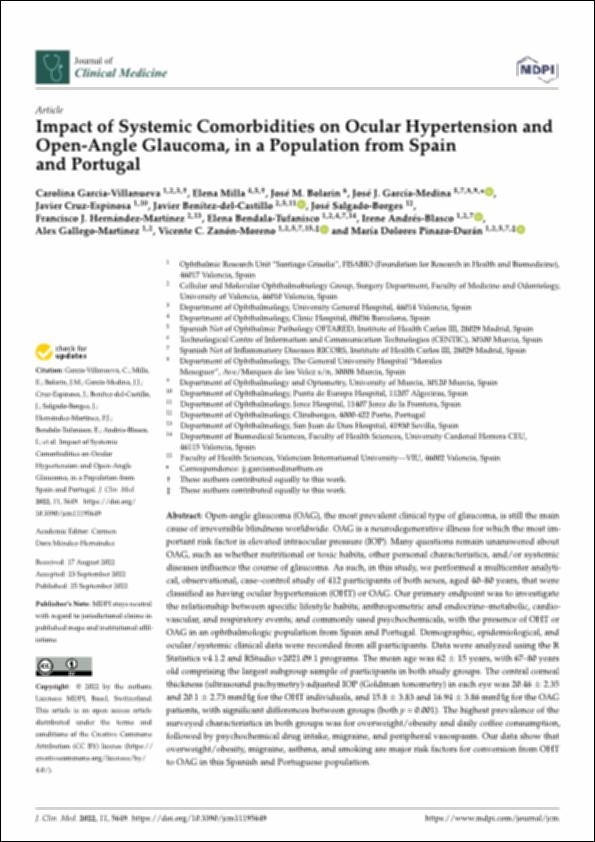Por favor, use este identificador para citar o enlazar este ítem:
http://hdl.handle.net/10637/14418Impact of systemic comorbidities on ocular hypertension and open-angle glaucoma, in a population from Spain and Portugal
| Título : | Impact of systemic comorbidities on ocular hypertension and open-angle glaucoma, in a population from Spain and Portugal |
| Autor : | García Villanueva, Carolina Milla, Elena Bolarín Guillén, José Miguel García Medina, José Javier Cruz Espinosa, Javier Benítez del Castillo, Javier Bendala Tufanisco, Elena |
| Materias: | Glaucoma - Factores de riesgo.; Glaucoma - Risk factors.; Intraocular pressure - Risk factors.; Eye - Diseases - Risk factors.; Presión intraocular - Factores de riesgo.; Nervio óptico - Enfermedades.; Optic nerve - Diseases.; Ojos - Enfermedades - Factores de riesgo. |
| Editorial : | MDPI |
| Citación : | Garcia-Villanueva, C., Milla, E., Bolarin, J. M., García-Medina, J. J., Cruz-Espinosa, J., Benítez-Del-Castillo, J., Salgado-Borges, J., Hernández-Martínez, F. J., Bendala-Tufanisco, E., Andrés-Blasco, I., Gallego-Martinez, A., Zanón-Moreno, V. C. & Pinazo-Durán, M. D. (2022). Impact of systemic comorbidities on ocular hypertension and open-angle glaucoma, in a population from Spain and Portugal. Journal of Clinical Medicine, vol. 11, i. 19 (25 sep.), art. 5649. DOI: https://doi.org/10.3390/jcm11195649 |
| Resumen : | Open-angle glaucoma (OAG), the most prevalent clinical type of glaucoma, is still the main cause of irreversible blindness worldwide. OAG is a neurodegenerative illness for which the most important risk factor is elevated intraocular pressure (IOP). Many questions remain unanswered about OAG, such as whether nutritional or toxic habits, other personal characteristics, and/or systemic diseases influence the course of glaucoma. As such, in this study, we performed a multicenter analytical, observational, case–control study of 412 participants of both sexes, aged 40–80 years, that were classified as having ocular hypertension (OHT) or OAG. Our primary endpoint was to investigate the relationship between specific lifestyle habits; anthropometric and endocrine–metabolic, cardiovascular, and respiratory events; and commonly used psychochemicals, with the presence of OHT or OAG in an ophthalmologic population from Spain and Portugal. Demographic, epidemiological, and ocular/systemic clinical data were recorded from all participants. Data were analyzed using the R Statistics v4.1.2 and RStudio v2021.09.1 programs. The mean age was 62 15 years, with 67–80 years old comprising the largest subgroup sample of participants in both study groups. The central corneal thickness (ultrasound pachymetry)-adjusted IOP (Goldman tonometry) in each eye was 20.46 2.35 and 20.1 2.73 mmHg for the OHT individuals, and 15.8 3.83 and 16.94 3.86 mmHg for the OAG patients, with significant differences between groups (both p = 0.001). The highest prevalence of the surveyed characteristics in both groups was for overweight/obesity and daily coffee consumption, followed by psychochemical drug intake, migraine, and peripheral vasospasm. Our data show that overweight/obesity, migraine, asthma, and smoking are major risk factors for conversion from OHT to OAG in this Spanish and Portuguese population. |
| Descripción : | Este artículo se encuentra disponible en la siguiente URL: https://www.mdpi.com/2077-0383/11/19/5649 En este artículo de investigación también participan: José Salgado-Borges, Francisco J. Hernández-Martínez, Irene Andrés-Blasco, Alex Gallego-Martinez, Vicente C. Zanón-Moreno y María Dolores Pinazo-Durán. Este artículo de investigación pertenece al número especial "Clinical Advances in Glaucoma". |
| URI : | http://hdl.handle.net/10637/14418 |
| Derechos: | http://creativecommons.org/licenses/by/4.0/deed.es |
| ISSN : | 2077-0383 (Electrónico) |
| Idioma: | es |
| Fecha de publicación : | 25-sep-2022 |
| Centro : | Universidad Cardenal Herrera-CEU |
| Aparece en las colecciones: | Dpto. Ciencias Biomédicas |
Los ítems de DSpace están protegidos por copyright, con todos los derechos reservados, a menos que se indique lo contrario.


